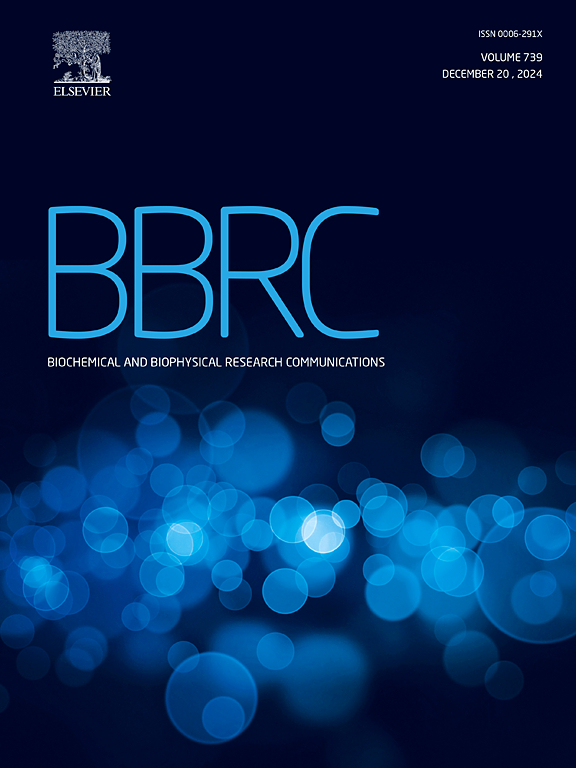Identification and determination of the urinary metabolite of iodotyrosine in vivo
IF 2.5
3区 生物学
Q3 BIOCHEMISTRY & MOLECULAR BIOLOGY
Biochemical and biophysical research communications
Pub Date : 2024-10-20
DOI:10.1016/j.bbrc.2024.150854
引用次数: 0
Abstract
Background
Congenital hypothyroidism screening traditionally relies on detecting elevated thyroid-stimulating hormone levels, yet this approach may not detect a specific type of congenital hypothyroidism caused by iodotyrosine dehalogenase-1 (Dehal1) deficiency. The deficiency of this enzyme prevents the deiodination of mono-iodotyrosine (MIT) and di-iodotyrosine (DIT) in the process of iodine recycling. This underscores the potential use of iodotyrosine or its metabolites as non-invasive urinary biomarkers for early diagnosis of congenital hypothyroidism. However, the urinary metabolites of MIT/DIT have not yet been discovered. Thus, this study aimed to identify the urinary metabolites of iodotyrosine in experimental models.
Method
Gas chromatography mass spectrometry was used to identify the urinary metabolites of iodotyrosine following intraperitoneal injection of MIT in rats. An isotope dilution mass spectrometric assay was developed for assessment of identified metabolites. Urine samples from Dehal1 knockout mice were used to confirm the results.
Results
We identified novel iodotyrosine metabolites, 3-iodo-4-hydroxyphenylacetic acid (IHPA), and 3,5-diiodo-4-hydroxyphenylacetic acid (Di-IHPA) as the primary urinary metabolites of MIT and DIT respectively. The concentrations of urinary IHPA and Di-IHPA were significantly higher in Dehal1 knockout mice.
Conclusion
Our findings suggest that IHPA is detected in larger quantities and may hold more clinical significance than previously identified biomarkers like MIT and DIT, making it a promising candidate for diagnosing congenital hypothyroidism or other conditions associated with iodine recycling inhibition.
体内碘酪氨酸尿代谢物的鉴定和测定。
背景:先天性甲状腺功能减退症的筛查传统上依赖于检测促甲状腺激素水平的升高,但这种方法可能无法检测出一种由碘酪氨酸脱卤酶-1(Dehal1)缺乏症引起的特殊类型的先天性甲状腺功能减退症。这种酶的缺乏会阻碍单碘酪氨酸(MIT)和二碘酪氨酸(DIT)在碘回收过程中的脱碘作用。这突显了碘酪氨酸或其代谢物作为非侵入性尿液生物标志物用于早期诊断先天性甲状腺功能减退症的潜力。然而,MIT/DIT 的尿液代谢物尚未被发现。因此,本研究旨在鉴定实验模型中碘酪氨酸的尿液代谢物:方法:采用气相色谱质谱法鉴定大鼠腹腔注射 MIT 后尿液中的碘代酪氨酸代谢物。开发了一种同位素稀释质谱测定法,用于评估已确定的代谢物。结果:结果:我们发现了新型碘酪氨酸代谢物--3-碘-4-羟基苯乙酸(IHPA)和 3,5-二碘-4-羟基苯乙酸(Di-IHPA),它们分别是 MIT 和 DIT 的主要尿液代谢物。Dehal1 基因敲除小鼠尿液中 IHPA 和 Di-IHPA 的浓度明显更高:我们的研究结果表明,与之前确定的生物标志物(如 MIT 和 DIT)相比,IHPA 的检测量更大,可能具有更重要的临床意义,使其成为诊断先天性甲状腺功能减退症或其他与碘回收抑制相关疾病的候选标志物。
本文章由计算机程序翻译,如有差异,请以英文原文为准。
求助全文
约1分钟内获得全文
求助全文
来源期刊
CiteScore
6.10
自引率
0.00%
发文量
1400
审稿时长
14 days
期刊介绍:
Biochemical and Biophysical Research Communications is the premier international journal devoted to the very rapid dissemination of timely and significant experimental results in diverse fields of biological research. The development of the "Breakthroughs and Views" section brings the minireview format to the journal, and issues often contain collections of special interest manuscripts. BBRC is published weekly (52 issues/year).Research Areas now include: Biochemistry; biophysics; cell biology; developmental biology; immunology
; molecular biology; neurobiology; plant biology and proteomics

 求助内容:
求助内容: 应助结果提醒方式:
应助结果提醒方式:


